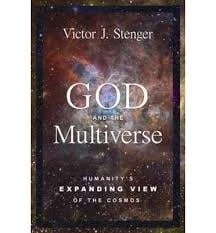God And The Multiverse by Victor J. Stenger (book review).
In many ways, Victor J. Stenger’s latest book, ‘God And The Multiverse’ covers elements of one of his previous books, ‘God And The Atom’, which he admits in his introduction. I do think perhaps that ‘God’ should be in plural because Stenger examines the evolution of cosmology across the world and how astronomers had to develop their proofs that the universe did not revolve around the Earth as seen by the various religious communities whose gods they worshipped. This was one victory that was hard but eventually won by sheer evidence without a god in sight to show anything miraculous happening.
Amongst the illustrations is one of Galileo showing how he mapped the moons of Jupiter, marking the dates as he saw them. It’s also interesting to note that the likes of Galileo and Newton didn’t actually turn away from having any faith at all but I would put that down to upbringing as much being surrounded by the church and them separating the two causes. Then again, think of your school education where you were religious education and the sciences and never the twain should meet. Something I hadn’t realised that apart from philosophy, that Immanuel Kant appreciated astrophysics.
You frequently come across the term ‘parallax’ as a means to measure stellar distance and if you want a graphic representation, then page 96 will serve you nicely.
When Stenger gets into the real science of the cosmos, religion really gets left behind, although one of the Popes thought there were parallels. With the rate Stenger goes the various discoveries, I suspect some of your heads will spin but as an overall reference book, you will come away with the historical evolution of discovery about the cosmos and what it means. The historical context is important because you will recognise names that have been used for the various effects and why these scientists were so important.
There’s an interesting observation that special relativity does not forbid particles travelling faster than the speed of light, just that they can’t go slower. Considering the example is tachyons, you have to wonder how scientists are trying to detect them because if it’s by collision then they must turn into something else.
The explanation of the strong and weak nuclear forces on page 136 is actually very comprehensive. You’ve come across these two as part of the four forces that keeps everything together and although the strong one keeps atom cores together, the weak one is what drives them apart. Still no explanation why but I still can’t help feel that both of these are different ends of a single force.
Stenger explains how neutrinos, passing through air or water, emits an electro-magnetic shockwave called Cherenkov radiation that photo-detectors can spot. Those of you who know or remember that these detectors are set deep underground to remove any background noise should recognise the connection now. His description of how the neutrino vibrates through three states shouldn’t be unfamiliar as this seems to be common with most atomic particles. No wonder we often detect them as wave pattern. All of this is home ground for Stenger as he worked in particle physics during these discoveries and gives the grounds for recognising dark matter as existing in three states as well. I’m still puzzled over why it should be spread out so far when you’d expect some clumping so it could be found easier though.
In the final chapters, Stenger touches on the multiverse and even hints a little at Science Fiction but not improbable to happen. I still think there needs to be some evidence to back it up. Then again, the same applies to the laws of science we recognise. In SF, we play around with scientific laws but often under special or certain conditions how such changes affect the other laws. When you consider how they all relate to each other, even in SF we do take some care with what we tamper with.
If you’re unfamiliar with all the science laws out there in the cosmos then this book is a gem of knowledge that you will refer to time and again. God comes a poor second to what is really going on out there.
GF Willmetts
October 2014
(pub: Prometheus Books. 447 page illustrated indexed hardback. Price: $26.00 (US), $27.50 (CAN). ISBN: 978-1-61614-970-3)
check out website: www.prometheusbooks.com





